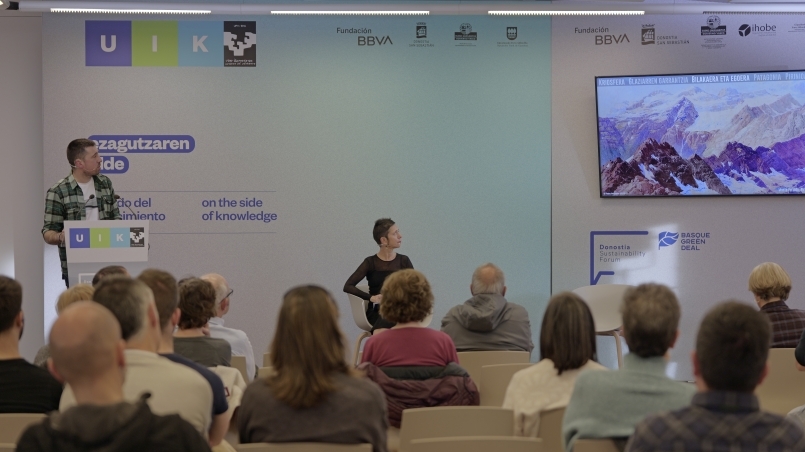Ayona Datta: “Artificial intelligence can be dangerous if it's in the wrong hands”
Ayona explores ethical digitalization and female empowerment in urban spaces
On September, Ayona Datta, Professor of Human Geography at University College London, gave a lecture at the Palacio Miramar in San Sebastian. During her talk, Datta reflected on the relationship between technology and cities. She also presented the "Feminist Toolkit," an initiative aimed at empowering women in digital spaces.
Can you talk about your work in Kenya? What did you do there, and what challenges did you face?
I work in Kenya as part of a larger project called Regional Futures, funded by the European Research Council. We’re comparing the metropolitan peripheries of rapidly growing cities in India, Kenya, and Mexico. In Kenya, we’re focusing on the outskirts of Nairobi—areas that are urbanizing quickly and, as a result, require rapid digitalization.
By that, I mean the land in these peripheries has traditionally been mapped on paper. Because urbanization is happening so fast, the government wants to digitize these areas to better understand what’s changing. In doing this work, we discovered that much of the peripheral land belongs to indigenous communities, particularly the Maasai. So, we’re observing a tension between urbanization and the appropriation of indigenous land.
This is a complex issue because indigenous communities also want to develop, grow, and improve their livelihoods. It’s a very interesting tension. We haven’t reached definitive conclusions yet, but so far, we’ve held a few stakeholder workshops where we’ve spoken with state officials and organizations that focus on land justice in Kenya. We’re trying to develop proposals that offer ways to digitize land records ethically.
What is your opinion about artificial intelligence?
I think artificial intelligence can be dangerous if it's in the wrong hands, especially when it’s developed without ethical guidelines. It can lead to misinformation and disinformation, as we’ve seen with events like the Cambridge Analytica scandal. But AI is also a broad term that encompasses many different things, so it’s hard to categorize it all as one concept.
Earlier forms of AI involved coding and creating algorithms, which we still use today. Now, we’re seeing new developments like ChatGPT and other generative AI models, which are a different evolution of AI. I think we need to be specific about what aspects of AI pose future risks and which are simply part of the normal development of technology that we need to make our lives more efficient.
I’m skeptical of the idea that AI will completely take over humanity. However, I do believe we need stronger laws, policies, and regulations to ensure it doesn’t become a tool for misinformation, disinformation, or used by rogue states to cause harm.
You talked about the "Feminist Toolkit", Can you explain what it is and its three stages?
The Feminist Toolkit came about from our work with women in working-class communities. We realized there was a lack of visibility for these women in digital spaces. It’s not that they didn’t have mobile phones—they did, and they were using apps like WhatsApp. But they weren’t authoring their own stories or sharing their experiences in the way we might do by writing blogs or posting on social media.
The idea behind the Feminist Toolkit is to give these women the tools to author their own stories. It consists of three stages: Refocus, Re-enable, and Re-imagine.
Refocus involves understanding the technologies these women are actually using. In some cases, they were using Nokia phones that weren’t even smartphones, or basic smartphones with limited data or network capacity. We also found that some were communicating in local languages written in the English script, which posed additional challenges.
Re-enable was about helping them to find their voices. We organized Wikipedia edit-a-thons to enable them to write about their neighbourhoods, held community podcasts, pop-up exhibitions, and used other strategies to enable them to tell their stories.
Re-imagine was about encouraging them to envision a different kind of world. For example, one group created a rap song that critiqued their surroundings and imagined a better future.
The Feminist Toolkit isn’t a strict formula. It’s more of an approach to enabling digital authorship. After participating, many women said it was the first time they felt they could share their stories with others and that people like them could benefit from hearing about their experiences and struggles.
Can you explain the five steps to achieving digital democracy?
This idea emerged from another project where we observed that many people, particularly in working-class minority communities, struggled to access information. In examining this issue, we identified key pillars of digital democracy.
The first step is access, specifically, how much access people have to technology and whether they can obtain information. However, as we discussed in the Summer Course, data is not the same as information. Data becomes information when it is processed and given meaning. From there, meaningful information leads to knowledge when people have the right kind of information, they gain a better understanding of their surroundings and situations.
The fourth stage is critical consciousness. At this point, individuals are able to critique and question the things they see around them rather than simply accepting what they’re told. This critical awareness naturally leads to action, where people can begin to challenge the status quo and make efforts to change things.
Finally, action leads to empowerment, where individuals are capable of taking meaningful actions based on their knowledge and critical thinking. We broke down the idea often presented by the Sustainable Development Goals, which suggests that owning a mobile phone equates to empowerment. Instead, we outlined six distinct steps to show that simply having access to a mobile phone is not the same as empowerment. There are several stages in between that must be achieved in order to truly reach empowerment. This is the pathway we propose to achieve digital democracy.

